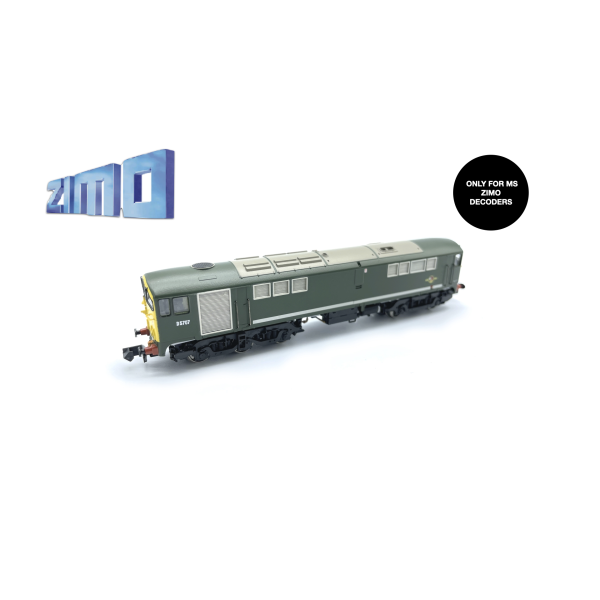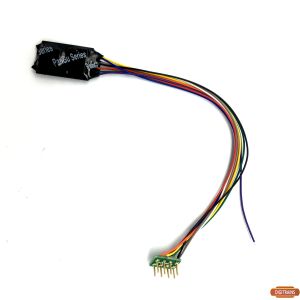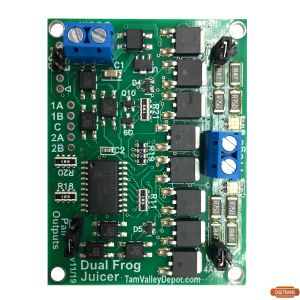MS28ASL Class 28 CO-BO Activedrive SL
F0 Headlights
F1 Sound on/off
F2 Brake Key (see text)
F3 Horn Hi (short)
F4 Horns (random)
F5 Light Load
F6 Compressor
F7 Speed Lock
F8 Fan
F9 Flange noise (Driving only)
F10 Tail reds off
F11 Cab door open/close
F12 Idle
F13 Guard whistle
F14 Station ambience
F15 Spirax valve
F16 Emergency Brake
F17 Fire bell
F18 AWS horn
F19 Mute if on
F20 Shunt mode
F27 Volume –
F28 Volume +
CV4 set to 100 for coasting use F2 to slow loco with the brakes
MS***** are new soundfiles designed to be used with Zimo MS range of decoder these files use 16bit 44kHz sound sample to get the full benefit out of this next evolution of Zimo sound decoders.
Zimo MS440 the first sound decoder from the ‘MS’ generation were conceived in 2019, as successors to the long-standing ‘MX’ decoders. The core of the MS sound decoders is formed by a state of the art 32 bit ARM microcontroller with ‘Dymanic Sound Processing’ characteristics and generously dimensioned memory. This enables sound reproduction of the highest quality.
REAL 16 bits audio – 22 or 44 kHz sample rate – 16 channels – 128 Mbit memory – Multiprotocol: DCC, mfx* , MM
What is ActiveDriveSL?
This is a system developed to allow more prototypical sounds to be deployed across a wide range of operating conditions.
The sounds have been programmed in such a way that you, the user, may change the way that the sounds respond to your driving style or needs. This avoids the need for reprogramming and all the additional costs that would imply.
Please note that in all driving schemes listed below, small speed step increases or decreases will normally produce the best results in terms of matching sounds to loco movement.
Some of the new controls will not operate correctly if you use 14 or 28 speed steps. Please ensure you use 127/128 speed steps to get maximum advantage of these important additions.
F2 Brake key
When closing the throttle the loco will coast and decelerate very slowly. To slow the train press F2 and the brakes actually work, slowing down the loco just like a real brake control in the cab.
Light Engine Mode
Activated by F5, this enables multi-function changes with one key. With small throttle increments the idle sound will be held for the first portion of driving, enabling yard movements etc without engine ramping. Alternatively, large throttle movements will produce a ramp up for a few seconds initially, after which the engine sounds will return to the level appropriate to the new speed.
This feature also automatically reduces inertia and momentum settings which you would expect of an unloaded loco, and delays automatic engine power increase ramps until higher road speeds are reached.
F5 can be operated at any speed to give another way in which the engine sounds at a given road speed may be modified instantly.
Speed Lock
This feature allows the road speed to be locked whilst the throttle control is used to control the engine power sounds playing.
Accurately simulating the sound of a heavy train slowly climbing a gradient with engine at full power is as easy as depicting it coasting down a gradient with the engine at Idle with this single new feature.
Here’s how it works.
Engage the SpeedLock Key, (F7) to fix the model’s road speed temporarily. The throttle now directly controls the engine sounds only. Increase speed steps to apply more power, decrease speed steps to spool the engine down to lower power bands or to Idle.
Disengage the SpeedLock Key when you wish to return control of the model’s speed to the throttle.
Live Volume Control
Provided the sound is switched on and the ‘fade’ button, F19, is not active, it is possible to change the overall volume to suit changing needs.
Engage F27 and the sound levels will gradually reduce, eventually to silence
Engage F28 and the sound levels will gradually increase, eventually to maximum.
In each case, disengage the F key when the desired level is attained. Set F27 and F28 as ‘momentary’ if your DCC controller allows you to do so.
Note: If the volume controls appear to not function, check that F19, F27 and F28 are disengaged before making a further attempt.
Troubeshooter
If decoder appears faulty at any time carry out a project reset setting CV8 to 8. This will restore your decoder to as shipped condition. It will also reset address to 3 again, original sounds will not be lost.





